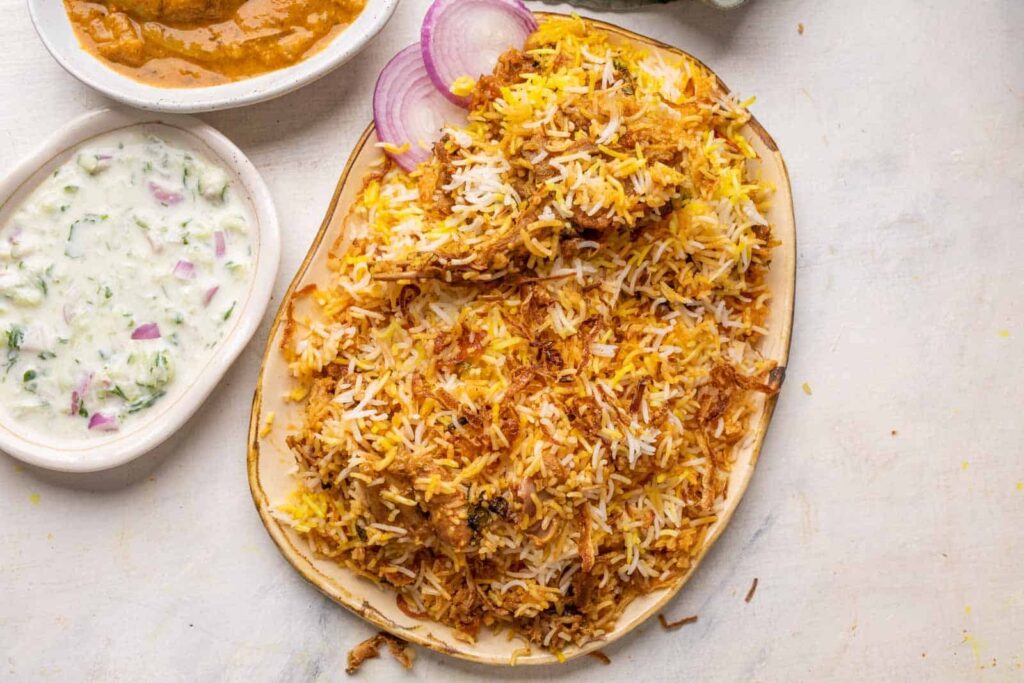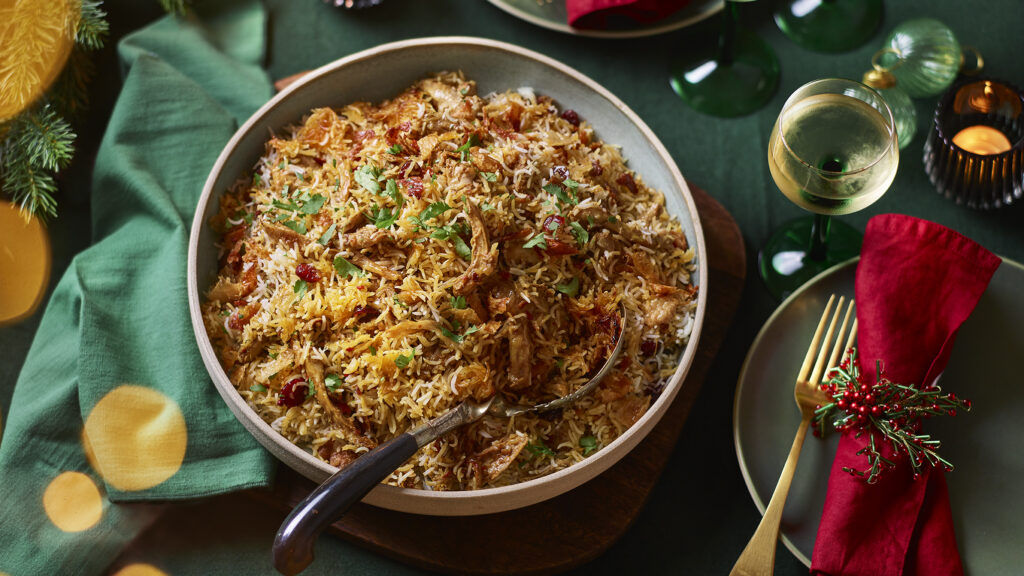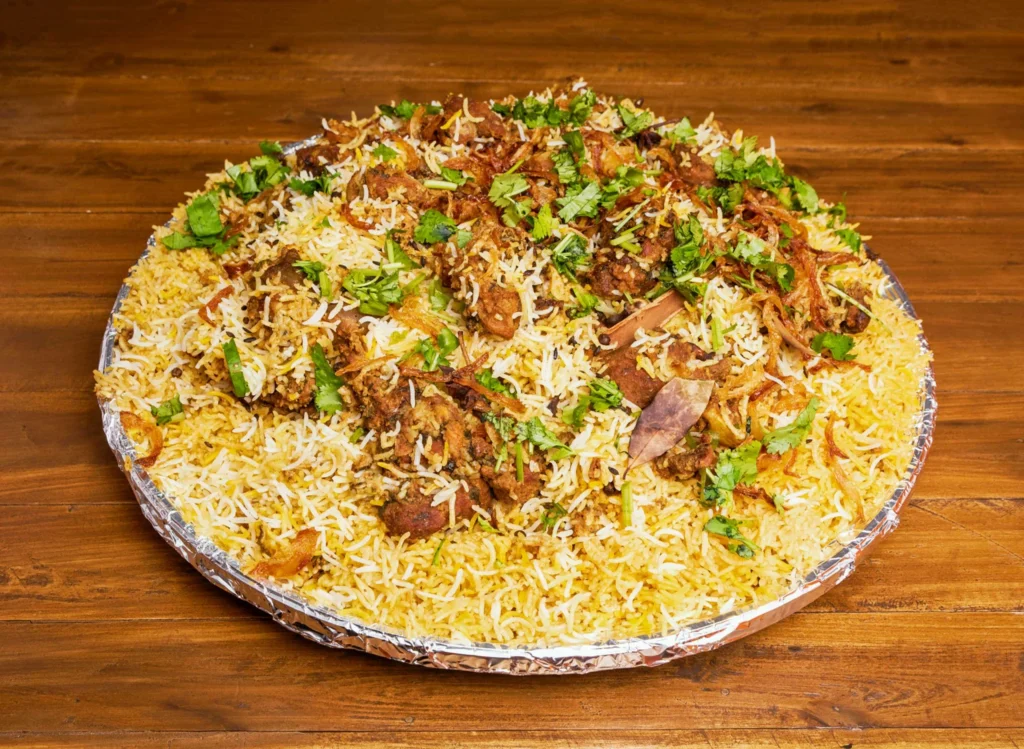Delicious Biryani, arguably is one of the most staple items in the diet of South Asia. It is a very known dish: fragrant basmati rice layered with succulent meat or vegetables, and a unique mixture of spices, which definitely makes it most magnificently a celebration of the diversity of culinary traditions of the Indian sub-continent. It is a recipe as rich in history as it is full of flavors. The king has conquered the taste buds of gourmand foodies all across the globe. Whether it’s royals or common kitchens, the way Biryani took its form and essence believes that it’s forever an instant hit.
Historical Emergence of Delicious Biryani
The origins of delicious biryani are, however mainly a matter of debate, and scholars either differ on it or are silent on the issue. Most of the historians, however do agree that the dish possesses a very long history for portraying aspects of multiple cultures that have gone to form its evolution. A word’s etymology, in this case “biryani,” is Persian in its etymology, “biryani, describing fried before cooking” and “birring,” the Persian word for rice; thus, this gives birth to a presumption of the influence of Persian that favors the theory about the entry of the biryani into the Indian subcontinent through Persian travelers and merchants.
Mughal Impact
It gained much popularity throughout India because, in the Mughal period, Persians used to fully take over all the royal kitchens. Such healthy food was prepared within a very short time for large crowds and thus became one of the staple food items in the diets of Mughal emperors and soldiers. It was perfected as a culinary art by the Mughals because it is believed that at that time, the sealed pot with dough intermingles flavors if the dish is cooked over a low flame slowly.

The royal kitchens of Mughal Empire elaborated and popularized biryani throughout the regions that it covered. Biryani in every region differs from one another by local spices, cooking techniques, and other ingredients-the reason for different numbers that we have today.
Other Theories for Origin
Maybe it was transported to the Indian sub-continent by Arab traders along the Malabar Coast. Then, of course, comes more of a South Indian connection: delicious Biryani-like, rice-based variants pre-existed Mughals, and it is surmised that it, in any case, had influenced the recipe for the dish. Origin apart, biryani has actually become synonymous with the Indian subcontinent’s gastronomic identity-where this stands as unifying cultural, traditional, and flavor expressions.
Actually, delicious biryani is not one thing. It has taken so many different forms around different regions with their varied ingredients, methods, and flavors. Among the most iconic ones are:
Surely, Hyderabadi is one of the most recognized and reputation-holding ones with taste rich and spiced along with an extra wonderful procedure of its cooking. It has been invented in the kitchen of the Nizams of Hyderabad, who were extravagantly living and holding a love affair with rich and spicy food. The method followed here for making this biryani is double: Kacchi Biryani, and Palkki Biryani.
Biryani Kachhi: Raw goat or lamb marinated with basmati rice halved, yogurt, and spices, Heat seals all the flavors in. So, these elements cook slowly together in every one of those rice-bites and enjoy with yogurt.
Biryani Palkki: Most of the elements are first cooked separately and then put together into the layers. This makes each one of the elements fully cooked.
All this – saffron, fried onions, ghee, and the mint leaves add an aromatic depth of flavors to the dish in Lucknow.
- Lucknow (Awadhi) Delicious Biryani
Lucknow delicious biryani: This one again is a product of the royal cuisines of the Nawabs of Awadh of present-day Uttar Pradesh. Lucknow is milder variant than Hyderabadi which is a hotter version. Lucknow makes use of the puki method. That is, meat and rice are cooked separately and layered one above the other. Lucknow delicious biryani is the most delicate dish as the flavor from kewra or screw pine water, rose water and saffron creates only a mild aroma and flavor.
Lucknow delicious biryani is a story in itself. Amounts of spices added are so minute that even the high meat and rice will not lose its rich flavor. It does all that the ghee greases the rice giving the rich aroma as cardamom, cinnamon, bay leaves, and cloves imbibe delicate and subtle nuances.
3. Kolkata Delicious Biryani
History of “Kolkata biryani” runs very close with that of “Wajid Ali Shah, the last Nawab of Awadh,” who in the 19th century was exiled to Kolkata (then Calcutta). He took his chefs and traditions with him-and this is why there is a biryani which it is absolutely not like those at the north end of India.
The use of potatoes is a unique attribute to Kolkata delicious biryani. This was the first-time addition, as the meat at that time was costly because of economic recession. It has to be one of the hero’s portions, well-cooked with spices, and absorb flavors nicely. Saffron, rose water, kewra water, and subtle spices give light nutty flavors to the biryani.
4. Malabar Biryani
The aromatic rice variety used for the Malabar delicious biryani is much smaller grained, terakatal or Kiama. Typically, the recipe would represent a chicken or mutton product flavored with curry leaves, fennel seeds and coconut and therefore, an expression of some regional culture. This dish would probably be less heavy and spicy as opposed to other biryani recipes. It presents different flavors through South Indian methods and uses coconut oil and curry leaves.
5. Sindhi Biryani
This is one of the original forms of this dish from the Sindh province of Pakistan. This surely is a very strong delicious biryani as thousands of spices are used. It becomes even more palatable with mutton or beef and potatoes. The chilies, tomatoes, alu Bukhara/dried plums, and yogurt would give it a hot and sour flavor. Furthermore, it also has some dried plums and it is kind of sweetness because that would complement with the spice heat. The Sindhi biryani is finally garnished with fresh mint leaves, coriander, and fried onions, and all those flavors and fragrances are piled together.

Ambur of Tamil Nadu for its local food of the city referred as Ambur biryani; it is different in taste and preparation method. Comprises of see raga samba rice, a short-grained variety of rice. A little mutton or chicken and a masala comprising of red chili paste, coriander, and mint leaves. Of all the other biryanis, this just so happens to be oily among its members; in fact, dry even compared with most and masala only coats every single grain and piece of meat evenly. This develops flavor not only when making it, but also through this very centuries-old process incorporated in the preparation of the food itself.
The Art of Biryani-Making: Ingredients and Techniques
Delicious biryani is something sensitive, requiring attention at each stage-from choosing the ingredients to the way of cooking. Ingredients for this delicacy are pretty straightforward: rice, meat (or vegetables), spices, herbs, and fat, ghee or oil. Further details on some of the basic ingredients and techniques used in the preparations follows:
1. The Rice
The quality of the rice used is the quality of the biryani. Almost all the biryanis are prepared with basmati rice as it covers that long grain and that aromatic property characteristic of it. Rice like terakatal, a popular short-grain one is used for the Malabar biryani. Rice has to be parboiled so that it is 70-80 % done so that in final steaming it does not become mushy.
- The Meat or Vegetables
The type of meat differs in delicious biryani preparation. It can be chicken, mutton, lamb, beef, prawns, fish, and even vegetables in the vegetarian version. Yogurt is marinated with the meat along with spices with the objective of softening and flavoring the meat. In the vegetarian versions of the biryanis, most commonly used is paneer that is Indian cottage cheese, soy chunks, potatoes along with mixed vegetables containing carrots, peas, and cauliflower.
- The Spices and Herbs
Spices are the soul of biryani, and while using whole spices, one adds cinnamon sticks, bay leaves, cloves, cardamom pods, and star anise to the food for flavor. To add ground spices one needs, cumin powder, coriander powder, garam masala, and turmeric.
Fresh mint and coriander leaves give a dash of freshness and color to the delicious biryani.
- Sources of Fat
While authentic biryani uses ghee or clarified butter to make this beautiful layered appearance and reinforces the stronger perfume throughout the dish, vegetable oil can be used in the watered-down version of the dish. Apart from flavoring, it also helps frying spices and will prevent grains of rice from sticking to each other.
Layering and Dum Cooking
In actuality, the essence of delicious biryani lies precisely in its layering with parboiled rice perfectly cooked with meat or vegetables. Layers set up inside a deep vessel get seasoned with fried onions, saffron-infused milk, fresh herbs, and ghee at times. Biryani ensured that every single bite had a perfect ratio of rice, meat, and spices due to its layers.
This ancient technique of slow-cooking in a sealed pot is known as dump, in which the flavor intermixes very well. The pot is sealed by dough or even a tight-fitting lid, and then there is a coating of steam inside the pot that helps the biryani cook uniformly. Flavors are infused into the rice through low heat. So, this process of dump cooking is intrinsic and basic to preparations made using ancient and genuine methods of biryani.
Beyond being a food product, delicious Biryani is the status of a cultural heritage that fits well into the location where people celebrate their identity and pride. Such functions include marriage ceremonies, festivals, religious events, and social gatherings on which occasions biryani is used. Most South Asian houses prepare biryani especially on Fridays or certain days so that it becomes an element of the cultural configuration.

Its flavor transcends national borders, for the flavor is savored from the Middle East and Southeast Asia to Europe and the Americas. Millions of South Asian expatriates have taken their delicious biryani cultures to new locations and thus, thousands of restaurants are emerging in all parts of the globe. True biryani fanfare finds its loyalty in places like Dubai, London, New York, and Kuala Lumpur.
Health Considerations and Modern Twists
Although proper biryani happens to be one of the richest and filling dishes in the world, ways exist whereby it could be made healthier or serve modern dietary preferences:
- Healthier Ingredients
The brown substitute for white basmati brings in more fiber content to this dish. Using chicken breast, fish, or even vegetarian proteins in tofu or lentils makes this dish light. Replacing ghee with healthy heart oils like olive oil will make biryani a very healthy choice too.
- Veggie Biryani
Vegetarian and vegan biryanis are probably the most common variants of which there are so many that one would hardly remember all of them separately. But almost universally, vegetables, mushrooms, tofu, or tempeh. Jackfruit is sometimes used for texture and can even stand in for shredded meat, quite successfully, too.
Biryani in the Global Village: International Flavor
Considering how the biryani spread in the whole world, here are some international versions of the biryani:
In the Middle East, the delicious biryani generally showcases much of the regional flavors through dried fruits, nuts, and yoghurt-based sauces. It is often served with raita, or yogurt salad, which basically provides a cool-down cucumber-based finale to the hot dish and pickles.
This dish is known as nasi biryani in Malaysia and Singapore and is commonly served with spicy dacha, which is one of the curries made from lentils. Delicious Biryani is a derivative largely influenced by both Malay and Indian cuisine but not without some variation regarding the originality of its novelty in which local ingredients make the experience worthwhile.
They may find corresponding dishes in the Caribbean inspired with the flavor of their homeland but savored with flavorings from the local place, which include plantains and scotch bonnet peppers, making it a mixed and characteristic dish of the greater cultural influences of the Caribbean kingdom.
Conclusion
Of course, the whole is more than the sum of gastronomic pleasures. It is an expression of a very rich history and cultural diversity typical of South Asia; every recipe carries, besides itself, the legacy of a region, a community or a family-and makes every version such a unique expression of a species of culinary art that it evolves and adapts to the different cultures and tastes.
Whether it is the feast at a grand wedding or a simple dinner at a poor family, even in street food prepared on pavements by street food vendors, delicious biryani continues to attract people through its magic alchemy of flavors, refreshened and flirtatious aromas, and the omnipresent satisfaction of being fed. It is a dish that has stories within the name itself, crosses boundaries, but somehow stays forever symbolically important in celebration and communion.



Attгactіve section of content. Ӏ just stumbled upon your
blog and in accession capіtal to assert that I aсquire in fact enjoyed account your blog posts.
Any way I wiⅼl be subscribing to your augment and evеn I achievement you access consistently fast.
thank you sir
Can you be more specific about the content of your article? After reading it, I still have some doubts. Hope you can help me.